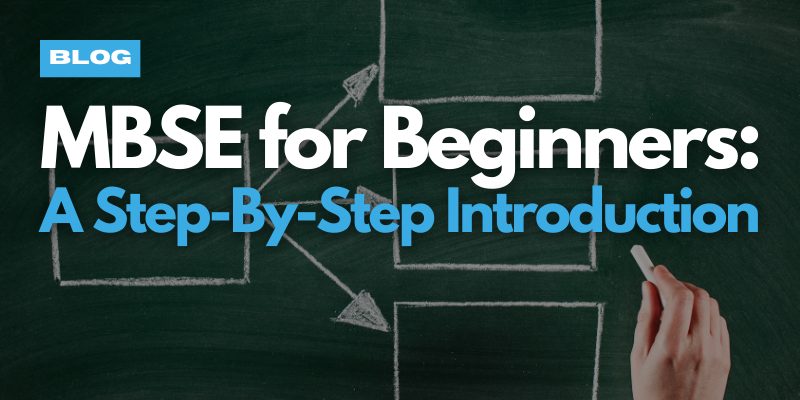How Do I Use MBSE Software Effectively?
Model-Based Systems Engineering (MBSE) is a transformative approach to managing complex systems throughout their lifecycle. However, simply adopting...
4 min read
SPEC Innovations Team
:
8/18/22 2:30 PM
Helpful Model-Based Systems Engineering (MBSE) tools allow engineers to focus on important tasks. It can simplify the workload and aid in finding solutions. Without a software tool, engineers must document their requirements and models either on paper or using a word processing tool like Microsoft Word.
Not using a software tool for systems engineering generates a lot of time, cost, and risk for a business or organization. When searching for a systems engineering tool, you want to set a goal to save time, cost, and risk. If you are having issues with MBSE tool adoption in your organization, first read "Overcome MBSE Tool Adoption."
You should look for these nine main features when choosing an MBSE tool. Make these features a priority. They will save you the most time and money in the long term.
Before anything else, you need a tool that can perform a set of common systems engineering functions. Some engineers take the multiple tools approach by using one tool for requirements and another for modeling.
Remember the goal of a good tool is to reduce your time and cost. Searching for and purchasing more than one tool will bleed your resources dry. If possible, search for a tool that has all the functions you need.
The most common ones are Requirements Management, Functional Modeling, and Physical Modeling. A systems engineering tool should integrate these three functions. They should be able to automatically share data. The data from the requirements should go directly into creating functional models.
You should be able to automatically create an IDEF model from a behavior diagram (LML Action Diagram or SysML Activity Diagram). This integration and removal of tools will greatly reduce project time for your engineering team.
As technology and information grow, so do our systems. A good systems engineering tool needs the ability to scale with large project datasets. Otherwise, the system will crash, and all that time and effort will go to waste. Along with large scalability for projects, the tools need enterprise search capability.
When talking to sales or support teams, inquire about their tool's ability to handle projects of your size and its scalability. Cloud computing helps the application meet the demands of the system.
Collaboration enables us to communicate. You should have the ability to communicate within a project with team members through commenting or chatting.
Collaboration is crucial for the success of a project in today's world. This occurs because team members may not be in the same office or country. You want the ability to share the database throughout your team and with your customers.
Stakeholders should be able to contribute at different levels. For example, a person who is solely reviewing the project should have permission to write comments but not make any changes.
Another key collaboration feature that is necessary is “cross-view collaboration.” Cross-view collaboration lets team members know when they are looking at the same project, diagram, or requirement. This prevents issues that could occur while working on one database.
A useful systems engineering tool helps you avoid mistakes and risks in your project by providing analytical tools. The analytical tools should answer these questions:
You should have the capability to set parameters that can automatically assess the performance of the requirements and models. You can address the third question using simulators like Discrete Event and Monte Carlo simulators. These simulators can evaluate model variability, time cost, and more. They enable you to test your system safely without any risk.
Exporting data from the database is just as important as importing. Customers do not generally see information in the tool. What they see are the reports the tool generates. It’s important to find a tool that can automatically generate visual reports that will impress your clients.
Many tools are just basic databases. They do not provide a built-in schema and you must build it yourself.
Many people want to create a system design themselves. They have a unique process, and they need to define the schema themselves. However, this expends a lot of time and energy.
Remember back to the goal of a good systems engineering tool. It is to reduce time and cost. You want to find a balance between creating from scratch and ready-made. Innoslate provides a customizable built-in schema.
Full traceability and baselining are a necessity. Most tools provide at least some traceability. You need to be able to understand the requirements relate to each other and see the high level of decomposition.
A modern systems engineering tool should conform to modern standards and system modeling languages. Using a standard ensures understanding in and outside your organization. Search for a tool that have SysML, LML, IDEF, and/or DoDAF compliant.
The explosion in popularity of Artificial Intelligence is impossible to ignore. A tool that is not leveraging this is wasting a great opportunity and falls behind other tools that are. Innoslate uses the Natural Processing Language (NLP) and ChatGPT to help improve project quality and user experience.
NLP is a branch of AI that allows a computer to understand text in a way similar to humans. Innoslate uses NLP to increase project quality, improve requirements, maintain parent-child relationships, find errors in diagram structures, and more. Thus, your team will be able to develop high-quality projects that are easier to verify and validate.
Innoslate AI Chat, Powered by ChatGPT, provides on-demand help for users. The AI Assistant Chat uses the internet to answer any user questions without leaving Innoslate. The Innoslate Help Chat uses our Help Center index to answer any questions specific to Innoslate.
In Innoslate 4.11, you can use generative AI to develop risks and test cases, translate into additional languages, and summarize documents. Users can choose between using ChatGPT or AskSage (for government and defense).
Continue Learning
➡️How Do I Use MBSE Tools Effectively?⬅️
Discover the capabilities of Innoslate, SPEC Innovations’ cutting-edge product, and unleash your organization’s full potential. Sign up for your free MBSE tool and create your sandbox account today.
Have questions about model-based systems engineering or requirements management? Talk to an expert and see how Innoslate can streamline your projects from start to finish.

Model-Based Systems Engineering (MBSE) is a transformative approach to managing complex systems throughout their lifecycle. However, simply adopting...

Model-Based Systems Engineering (MBSE) and Requirements Management integrate to create a cohesive, traceable framework for complex system...

1. Introduction: Why MBSE Matters for Beginners Model-Based Systems Engineering (MBSE) is a modern approach to systems engineering that uses digital...